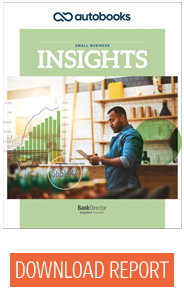
Regaining Control of Small Business Relationships
Brought to you by Autobooks

 In May 2020, Shopify announced a slate of products to help the e-commerce company better serve its 1.7 million clients, ranging from large merchants like Staples to small businesses. One of these products poses a direct threat to financial institutions: Shopify Balance, an account that includes cash flow analysis, expense tracking and bill pay. It even features a card that can be used in-person, digitally and at ATMs, along with cashback rewards and discounts.
In May 2020, Shopify announced a slate of products to help the e-commerce company better serve its 1.7 million clients, ranging from large merchants like Staples to small businesses. One of these products poses a direct threat to financial institutions: Shopify Balance, an account that includes cash flow analysis, expense tracking and bill pay. It even features a card that can be used in-person, digitally and at ATMs, along with cashback rewards and discounts.
Shopify uncovered a gap in the market. Most banks force their small business clients to use consumer banking or complex commercial products that don’t suit their needs. Lacking a strong solution from their primary financial institution, they’ll shift their business elsewhere. That’s what Shopify, and competitors like Square, Intuit’s QuickBooks and PayPal Holdings, are betting on. The services these companies offer target 80% of small business banking revenue, according to the research firm Celent.
Community banks and credit unions can’t afford to cede market share to these competitors. They need to create the same stickiness they’ve achieved with retail banking options like direct deposit. When that happens, “money first goes to you, and you’re going to be locked into that relationship,” explains Derik Sutton, vice president of marketing at Autobooks.
Customers now have seemingly infinite ways to pay, leading small businesses to adopt numerous solutions. Using Autobooks, “business owners regain control of how customers pay them,” says Sutton. By extension, the financial provider ensures that incoming deposits are safely in the bank – not with a competitor.
For a downloadable version of this report, click here. To access more resources about the small business market, click here.

